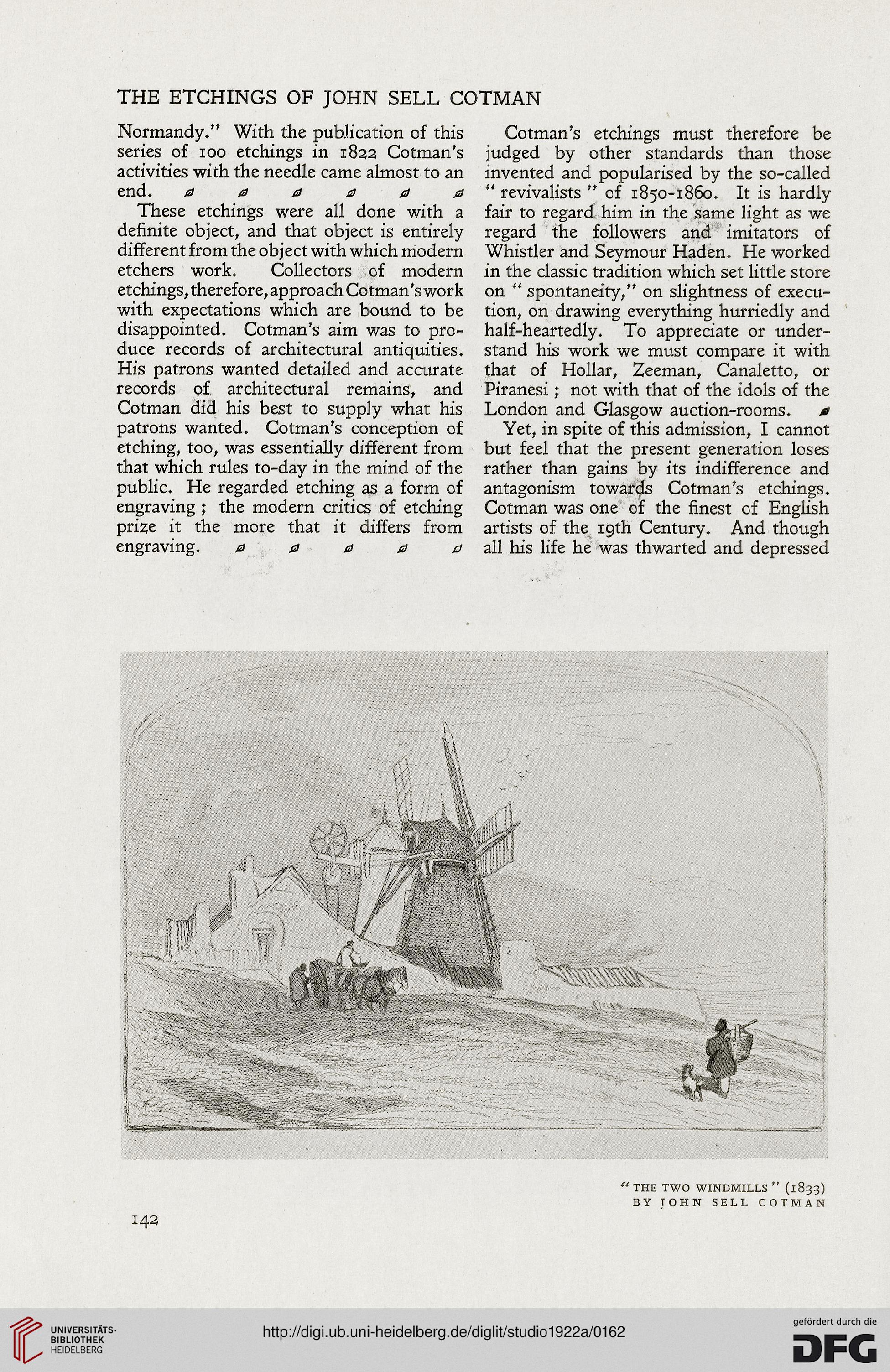THE ETCHINGS OF JOHN SELL COTMAN
Normandy." With the publication of this
series of 100 etchings in 1822 Gorman's
activities wich the needle came almost to an
end. 0 0 0 0 0 0
These etchings were all done with a
definite object, and that object is entirely
different from the object with which modern
etchers work. Collectors of modern
etchings, therefore, approach Cotman's work
with expectations which are bound to be
disappointed. Cotman's aim was to pro-
duce records of architectural antiquities.
His patrons wanted detailed and accurate
records of architectural remains, and
Cotman did his best to supply what his
patrons wanted. Cotman's conception of
etching, too, was essentially different from
that which rules to-day in the mind of the
public. He regarded etching as a form of
engraving ; the modern critics of etching
prize it the more that it differs from
engraving. 00000
Cotman's etchings must therefore be
judged by other standards than those
invented and popularised by the so-called
" revivalists " of 1850-1860. It is hardly
fair to regard him in the same light as we
regard the followers and imitators of
Whistler and Seymour Haden. He worked
in the classic tradition which set little store
on " spontaneity," on slightness of execu-
tion, on drawing everything hurriedly and
half-heartedly. To appreciate or under-
stand his work we must compare it with
that of Hollar, Zeeman, Canaletto, or
Piranesi; not with that of the idols of the
London and Glasgow auction-rooms. 0
Yet, in spite of this admission, I cannot
but feel that the present generation loses
rather than gains by its indifference and
antagonism towards Cotman's etchings.
Cotman was one of the finest of English
artists of the 19th Century. And though
all his life he was thwarted and depressed
" THE TWO WINDMILLS " (1833)
BY JOHN SELL COTMAN
142
Normandy." With the publication of this
series of 100 etchings in 1822 Gorman's
activities wich the needle came almost to an
end. 0 0 0 0 0 0
These etchings were all done with a
definite object, and that object is entirely
different from the object with which modern
etchers work. Collectors of modern
etchings, therefore, approach Cotman's work
with expectations which are bound to be
disappointed. Cotman's aim was to pro-
duce records of architectural antiquities.
His patrons wanted detailed and accurate
records of architectural remains, and
Cotman did his best to supply what his
patrons wanted. Cotman's conception of
etching, too, was essentially different from
that which rules to-day in the mind of the
public. He regarded etching as a form of
engraving ; the modern critics of etching
prize it the more that it differs from
engraving. 00000
Cotman's etchings must therefore be
judged by other standards than those
invented and popularised by the so-called
" revivalists " of 1850-1860. It is hardly
fair to regard him in the same light as we
regard the followers and imitators of
Whistler and Seymour Haden. He worked
in the classic tradition which set little store
on " spontaneity," on slightness of execu-
tion, on drawing everything hurriedly and
half-heartedly. To appreciate or under-
stand his work we must compare it with
that of Hollar, Zeeman, Canaletto, or
Piranesi; not with that of the idols of the
London and Glasgow auction-rooms. 0
Yet, in spite of this admission, I cannot
but feel that the present generation loses
rather than gains by its indifference and
antagonism towards Cotman's etchings.
Cotman was one of the finest of English
artists of the 19th Century. And though
all his life he was thwarted and depressed
" THE TWO WINDMILLS " (1833)
BY JOHN SELL COTMAN
142




